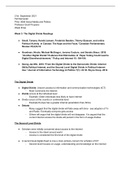Class notes
The Digital Divide
- Institution
- Dalhousie University (Dal )
This document speaks to the breakdown of digitization in the political sphere. The impacts of internet polling and social media usage in a ever growing climate digital age. It looks at the differing digital divides from the first to third with an entire breakdown of each. As well as how the dispari...
[Show more]



